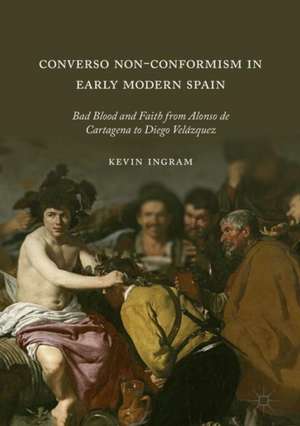Converso Non-Conformism in Early Modern Spain: Bad Blood and Faith from Alonso de Cartagena to Diego Velázquez
Autor Kevin Ingramen Limba Engleză Paperback – 18 feb 2020
| Toate formatele și edițiile | Preț | Express |
|---|---|---|
| Paperback (1) | 218.98 lei 6-8 săpt. | |
| Springer International Publishing – 18 feb 2020 | 218.98 lei 6-8 săpt. | |
| Hardback (1) | 653.65 lei 6-8 săpt. | |
| Springer International Publishing – 3 ian 2019 | 653.65 lei 6-8 săpt. |
Preț: 218.98 lei
Nou
Puncte Express: 328
Preț estimativ în valută:
41.90€ • 45.66$ • 35.31£
41.90€ • 45.66$ • 35.31£
Carte tipărită la comandă
Livrare economică 23 aprilie-07 mai
Preluare comenzi: 021 569.72.76
Specificații
ISBN-13: 9783030404307
ISBN-10: 3030404307
Pagini: 370
Ilustrații: XX, 370 p. 12 illus. in color.
Dimensiuni: 148 x 210 mm
Greutate: 0.47 kg
Ediția:1st ed. 2018
Editura: Springer International Publishing
Colecția Palgrave Macmillan
Locul publicării:Cham, Switzerland
ISBN-10: 3030404307
Pagini: 370
Ilustrații: XX, 370 p. 12 illus. in color.
Dimensiuni: 148 x 210 mm
Greutate: 0.47 kg
Ediția:1st ed. 2018
Editura: Springer International Publishing
Colecția Palgrave Macmillan
Locul publicării:Cham, Switzerland
Cuprins
1 Introduction.- 2 From Toledo to Alcalá.- 3 From Alcalá to Seville and Beyond.- 4 The Way Out of Trent.- 5 Four Humanists.- 6 Diego Velázquez and the Subtle Art of Protest.- 7 The Converso Returns.
Recenzii
“Converso Non-Conformism in Early Modern Spain: Bad Blood and Faith … sets out to account for the experience of those Spanish Jews, perhaps one-third of the total Spanish Jewish population, who converted to Catholicism after the Reconquista. … An outstanding study of its subject, Converso Non-Conformism in Early Modern Spain looks to be advancing an agenda setting argument.” (Crawford Gribben, New Books network, newbooksnetwork.com, February 07, 2019)
Notă biografică
Kevin Ingram is Professor of History at Saint Louis University, Madrid Campus, Spain.
Textul de pe ultima copertă
This book examines the effects of Jewish conversions to Christianity in late medieval Spanish society. Ingram focuses on these converts and their descendants (known as conversos) not as Judaizers, but as Christian humanists, mystics and evangelists, who attempt to create a new society based on quietist religious practice, merit, and toleration. His narrative takes the reader on a journey from the late fourteenth-century conversions and the first blood purity laws (designed to marginalize conversos), through the early sixteenth-century Erasmian and radical mystical movements, to a Counter-Reformation environment in which conversos become the advocates for pacifism and concordance. His account ends at the court of Philip IV, where growing intolerance towards Madrid’s converso courtiers is subtly attacked by Spain’s greatest painter, Diego Velázquez, in his work, Los Borrachos. Finally, Ingram examines the historiography of early modern Spain, in which he argues the converso reform phenomenon continues to be underexplored.
Caracteristici
Charts converso non-conformism from the mid-fourteenth century to the seventeenth century across Spain Reconsiders the work of Diego Velázquez as a converso humanist Highlights the importance of the conversos’ reform voice against the backdrop of modern Spanish state building and the creation of national identity
